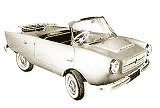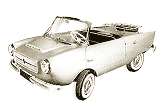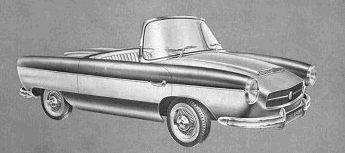| Henry Meadows Limited was founded in 1920 to
manufacture high quality 3 speed gearboxes for cars at their
Park Lane works. The company soon grew, and in 1922 added petrol
engines to the product range, and began to supply many famous
manufacturers including Lagonda, Invicta, Lea Francis, Bean and
Frazer-Nash. |
|
Just before the Second World War the company started to
experiment with diesel engines, and in 1947 produced a range of
diesel units for use in vehicles.
Meadows also worked jointly with D. Wickham & Company Limited, of Ware, to produce diesel engines
for railway locomotives.
The Factory expanded with the opening of a new works in
Cannock Road, next to the existing factory.
The site now covered over 14 acres and the company employed
more than 1,200 people, but was eventually taken over to become
part of the Associated British Engineering Company. |

An advert from 1951.
|
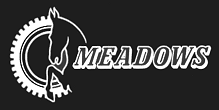
|
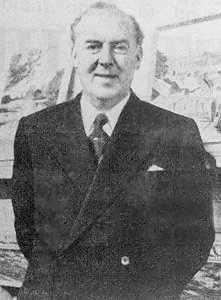
Mr. Lawrence Robson. |
Racing driver Raymond Flowers had the idea of
producing a small car, whilst living in Egypt. He intended to
call the car 'Rameses', and approached manufacturers both here and
abroad in the hope that one of them would agree to add the
vehicle to their product range. He had very little success with
his venture until he contacted Mr. Lawrence Robson, Chairman of
Henry Meadows Limited. Lawrence liked the idea, and the company decided to go ahead with the project.
The new car was to be called the 'Frisky', and
although Raymond Flowers had an initial design, this was not
used. Ex-Kieft employee Gordon Bedson joined Meadows as Export
Sales Manager, and became involved in the Frisky project. He
designed an initial prototype nicknamed 'The Bug'. Another
ex-Kieft employee Keith Peckmore joined the company to build the
prototype chassis.
|
|
The new Frisky made its first public appearance at the 1957
Geneva Motor Show with fibreglass bodywork designed by top
Italian stylist Michelotti, and produced by Vignale of Turin.
|
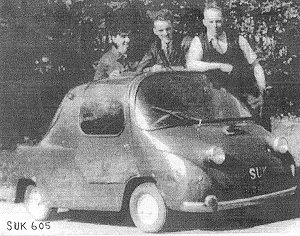
An initial prototype using the first body
mock-up, which was nicknamed "The Bug". Courtesy of Grant
Kearney. |
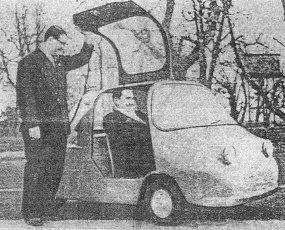
Another prototype body showing the
gull-wing door held open by Gordon Bedson. From an old factory
news release that appeared in "Rum Car". |
The two-seater car, powered by a two cylinder,
two stroke air cooled, 250c.c. Villiers engine, had a narrow
rear track of only 2ft 8inches, to obviate the need for a
differential.
It had a top speed of 65m.p.h., a fuel consumption of only
65m.p.g., ample room inside for two adults, and two gull-wing doors. Although an impressive machine, it was
still a prototype, production hadn’t yet started. |
| The Frisky production was in the original Meadows
works in Park Lane, and had its own entrance.
The offices were at the front, with the body bay and assembly
area behind. The company employed around 25 people and the cars
were assembled by hand. |
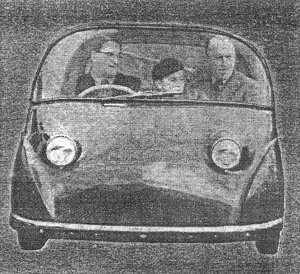
Gordon Bedson in the driving seat of a
prototype.
Courtesy of Keith Peckmore. |
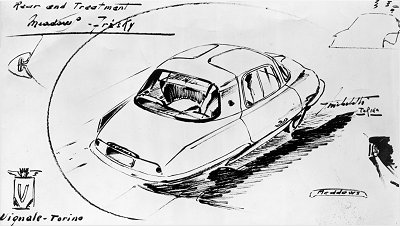
One of Michelotti's
original sketches showing the rear of the car.
Courtesy of Keith Peckmore. |
|
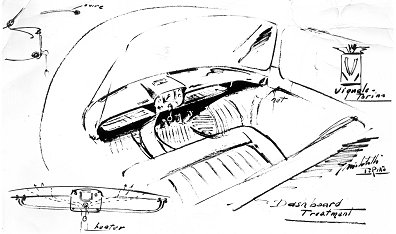
| Another of
Michelotti's original sketches; this one shows the
interior. Courtesy of Keith Peckmore. |
|
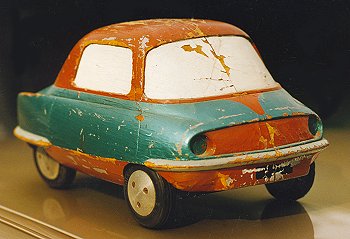 |
The photograph shows the
original wooden model of the first body design.
Courtesy of John Meadows. |
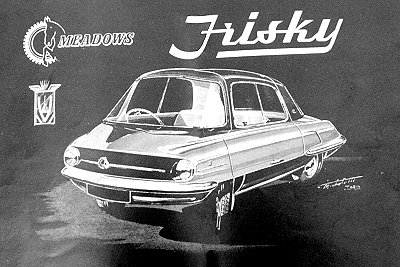
The front cover of the early Frisky sales literature showing
the gull-wing body that never went into production. |
| The Michelotti gull-winged bodied
car at the 1957 Geneva Motor Show. Only two of these bodies
were ever produced. The
engine arrived at the show from Wolverhampton and the
chassis and body came directly from Turin.
Photo courtesy of Keith Peckmore. |
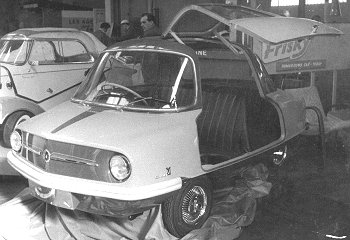 |
| The car was favourably reported in the press, and
expectations were high. As can be seen from the following
report about the new car, which appeared in the Express &
Star. |
|
Wolverhampton’s ‘Bubble Car’ Shakes Germans
Geneva, Thursday.
Britain’s first baby
“bubble car”, the Wolverhampton made Frisky,
being shown for the first time at the 27th
International Motor Show at Geneva today, is
worrying West German firms who have hitherto
dominated the continental market for baby cars.
This little four-seater British “giant” is
powered by a Villiers 250c.c. rear engine, with
coachwork designed by the Italian Giovanni
Michelotti. “We are most anxious to see this
British baby”, one West German said. “From all
accounts, it has plenty of style and go, and
with its four wheels and larger seating capacity
it looks like a winner.”
At the Henry Meadows, Ltd.,
factory in Wolverhampton today the interest
which has resulted from the Frisky announcement
was described to the Express and Star motoring
correspondent as “fantastic”.
400 Letters a Day
The company received 400
letters about the car on Tuesday, the day after
its announcement. There were a further 300
letters yesterday and letters are still arriving
in large numbers. Both men concerned in the
car's design, Mr. Gordon Bedson, Meadows’
Export Sales Manager, and Mr. Raymond Flowers, are at
Geneva. Mr. Flowers has said he thinks the
proposed production schedule of 1200 a week will
have to be increased. Many of the cars will be
exported.
At the Meadows factory
everyone is waiting for a day later in the month
when the first of the Italian bodied Friskys
arrives back from Geneva. Up to this morning no
one had seen more than a drawing and a small
model of the car in its final shape. |
|

| The first production model, the 'Frisky Sport'
appeared at the Earls Court show in 1957, looking very different
to the Geneva prototype. The gull-wing doors had gone, and
open-topped, and hard-topped versions were produced. Before
production began it was extensively tested by Keith Peckmore who
drove one as far afield as Stuttgart, and down to Devon. It
proved to be very reliable. Moulds for the new fibreglass bodies
were built in-house, and so were a few of the bodies, but most
were made at the nearby Guy factory where a fibreglass body
plant had been set up to make lorry cabs.
The car, powered by a 2 cylinder, 2 stroke, 325 cc. Villiers
engine, had a welded steel tube chassis with roller
chain transmission in an oil bath. |
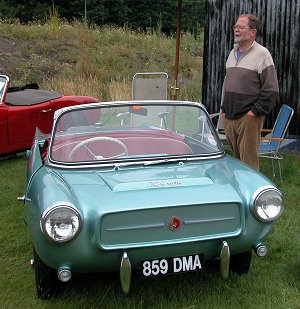
John Meadows standing by his immaculate
Frisky Sport at the 2005 Black Country Vehicle Rally. |
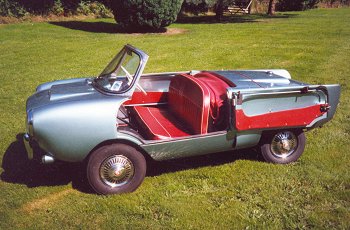
Another view of John Meadows' car.
Courtesy of John Meadows. |
It had a cruising speed of 65m.p.h. and a fuel
consumption of 60m.p.g. with room for 2 adults and a child. It
could however be a tight squeeze for a larger or taller person.
The only protection from the weather in the open bodied version
was a vinyl hood, which clipped onto the body and could be
stored behind the seat. For its size the car had an impressive
performance, but only a small number were made. Mainly because
of low sales and the high selling price of £484. |
| A newspaper article that came from a
cutting, from an unknown newspaper. It is from
the collection of the late Jim Boulton:
Came off the production line
in the Black Country and caused a sensation!
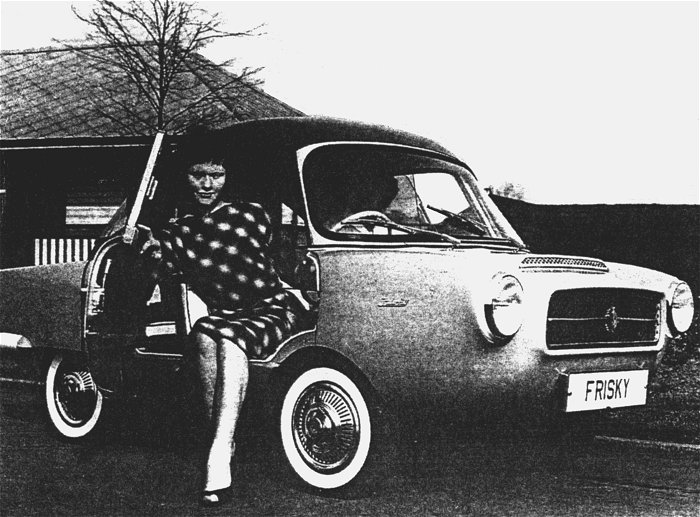
| A 1950s publicity photograph
showing one of the first Henry
Meadows made (Frisky) bubble-cars to
come off their Wolverhampton
production line. The car was
launched at the Geneva and Earls
Court motor shows, and even Prime
Minister Harold Macmillan tried it
out for size and comfort. |
The Black Country in
general, and Wolverhampton in particular, was
famous during the last century for the
manufacture of all kinds of vehicles - from
bicycles through to aeroplanes.
However, one of the most
unusual, and possibly one of the last, mass
produced vehicles to be made in Wolverhampton,
was the 'Frisky' bubble-car! How many readers
recall owning one or even seeing versions of the
'Frisky' on the roads of the Black Country or
further afield?
The photograph above, which
belongs to Mr. Ronald R. Smith, of Knowle,
Solihull, shows the car, fresh off the
production line, around 1957, with a couple of
ladies adding a female touch to the picture. Mr.
Smith has every reason to remember the 'Frisky',
as he was the publicity manager of Henry Meadows
Ltd., of Wolverhampton, at the time. They were
the manufacturers of the car, as Mr. Smith
explains in his brief covering letter.
"This was the first British
'bubble car' to be produced, preceding the
Austin 'Mini' by several years. The car was made
by Henry Meadows Ltd., whose main products were
diesel engines, gearboxes and power generating
plants, at their factory in Fallings Park. The
car was given the name 'Frisky', and was powered
by a Villiers engine. It was first introduced at
the Geneva motor show and later at the 1957
Earls Court motor show, where it caused quite a
sensation and received world wide publicity.
Some prominent politicians of the day including
the then Prime Minister, Harold Macmillan and
one Bessie Braddock tried out the driving seat
of the car at the show." |
|
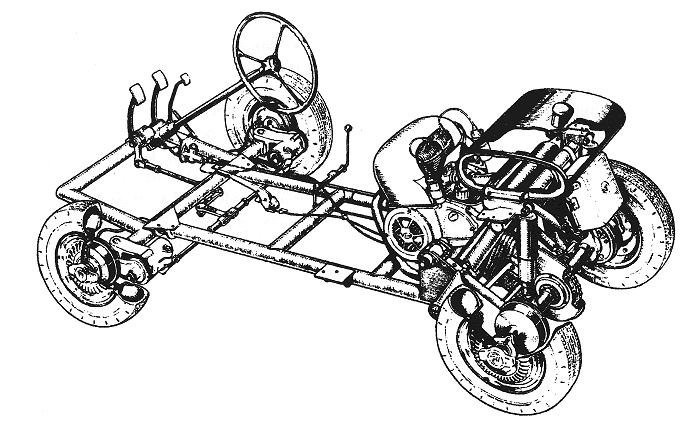
The 'Frisky Sport'. From 'The Motor', October
16th, 1957.

Also from 'The Motor', October 16th, 1957.
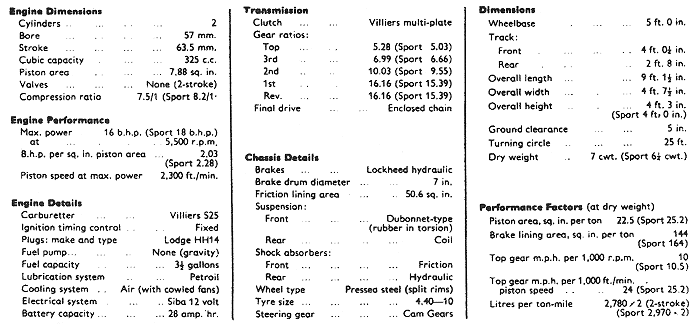
Also from 'The Motor', October 16th, 1957.
| John Meadows seated in a
hard-topped Frisky Coupe at the 2004 Black Country Vehicle
Rally.
Courtesy of Rod Bishop. |
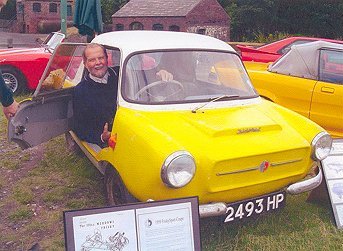 |
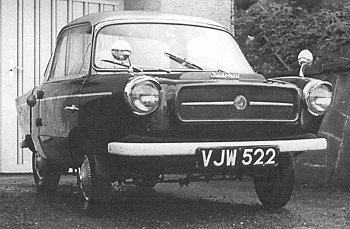 |
Another view of a
hard-topped Frisky Sport. This prototype was photographed whilst
undergoing road trials in Germany.
Courtesy of Keith Peckmore. |
| The front page of the sales
literature. |
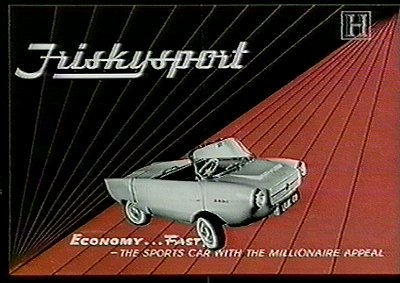 |
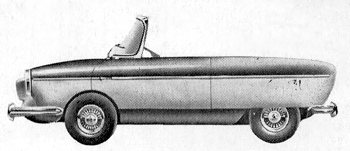 |
Another photograph from the
Frisky Sport sales literature.
This image was produced as part of a
styling exercise. No such car was ever built.
Courtesy of the late Jim Boulton. |
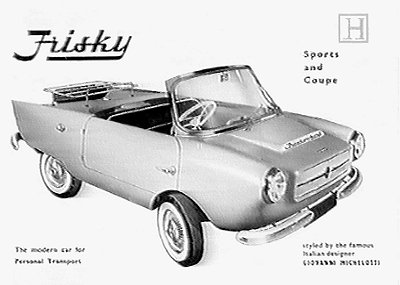
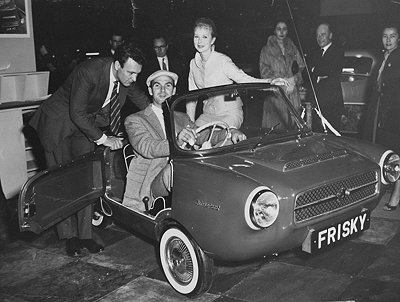
|
The Frisky Sport at
the 1957 London Motor Show with Rank
Organisation artists (L to R) Donald Sinden, Stanley
Baker and June Laverick. Courtesy of Keith Peckmore. |
|
| The Frisky Sport from above.
Courtesy of the late
Jim Boulton. |
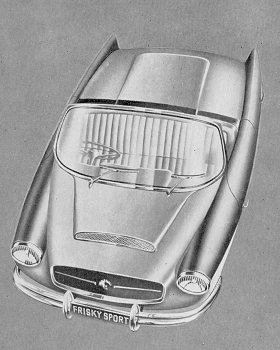 |
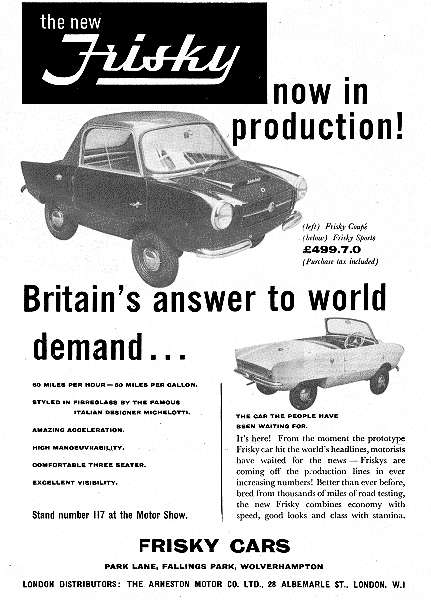
An advert from October 1958.
| In 1958 the company became Frisky Cars Limited, and a
new sports car, the 'Frisky Sprint' appeared. The elegant new
design was powered by a three cylinder 492cc, two stroke
Excelsior engine that developed 30b.h.p. Keith Peckmore who
built the prototype, took it up to 90m.p.h. during a test run. |
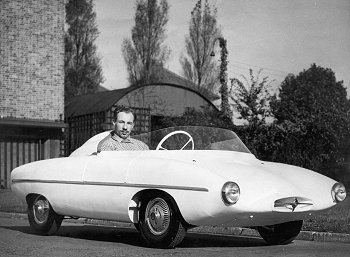
| Keith Peckmore at
the wheel of the Frisky Sprint. Courtesy of Keith
Peckmore. |
|
The car made its appearance at the 1958 Earls
Court Motor Show but never reached production.
Because all Friskys were hand-built, the car would have sold
for over £700 and so could not have competed with the mass-produced
competition. |
| Another view of the Sprint,
this time inside the factory surrounded by Frisky Sports.
Courtesy of Thoroughbred and Classic
cars. |
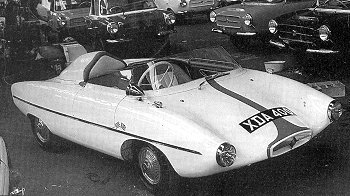 |
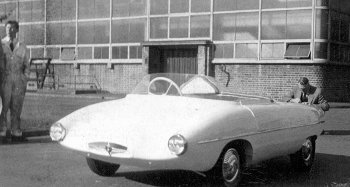 |
The Sprint outside the
works.
Courtesy of Keith Peckmore. |
| Raymond Flowers and his two brothers left the
project after about two years and moved on to other things. In
1959 the company was again reformed, this time as Frisky Cars
(1959) Limited, as a result of a take-over by Wright's Haulage.
A
new three-wheeled car, the 'Family Three' was developed. It
could carry two adults and two children, and was powered by a Villiers 197c.c. engine. Later an Excelsior 250c.c.
twin-cylinder two stroke version became available. The body was
produced by Hills Fibreglass Developments at their Wednesfield
factory. |
| In February 1959 Gordon Bedson began negotiating
with Lightburn & Company Limited, Adelaide, Australia. About two
months later both he and Keith Peckmore joined the company and
helped to design and build the 'Lightburn Zeta' that was based
on the 'Sprint'. It used a Frisky chassis fitted with an FMR
engine, as used in the Messerschmitt 'Tiger' cars. |
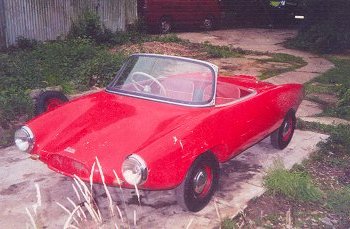
| The prototype
Australian 'Lightburn Zeta'. Courtesy of John Meadows. |
|
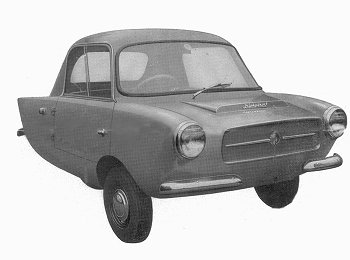 |
A Frisky “Family Three” from
1959.
Courtesy of John Meadows. |
| Frisky cars never sold well, and it was always a
struggle to keep the company going. The company changed hands
several times, but production of the cars stayed at the Meadows'
factory until its final move to Sandwich, Kent, in 1961, where a few of the final
model, the 'Prince' were built. Unfortunately
manufacturing problems soon brought production to an end in 1964.
It is thought that around
1,200 Friskys were produced at the Wolverhampton works.
|
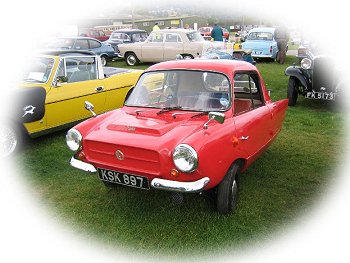
| Another 'Family
Three'. Courtesy of John Meadows. |
|
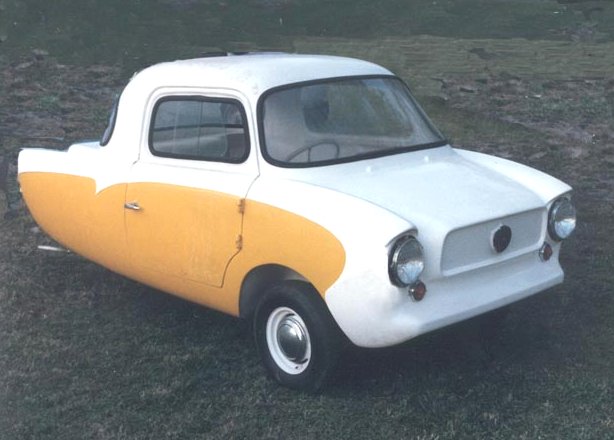
| A Frisky 'Prince'.
Courtesy of John Meadows. |
|
For some time after production ended spares were
available from Frisky Spares and Service Limited, Queenborough. |
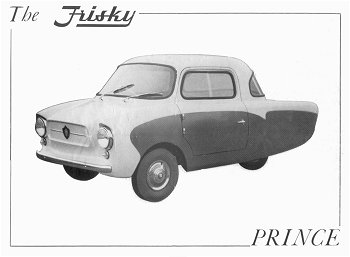
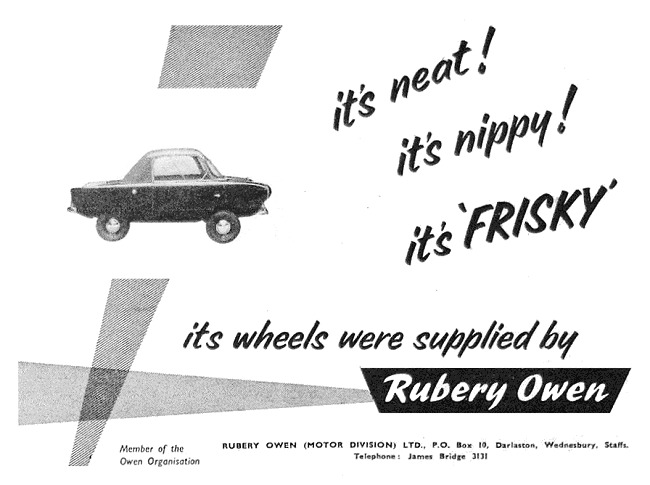
An advert from 1958.
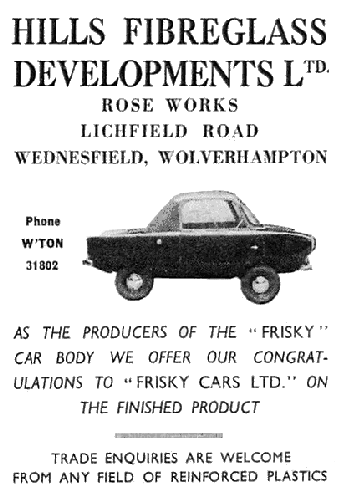 |
|
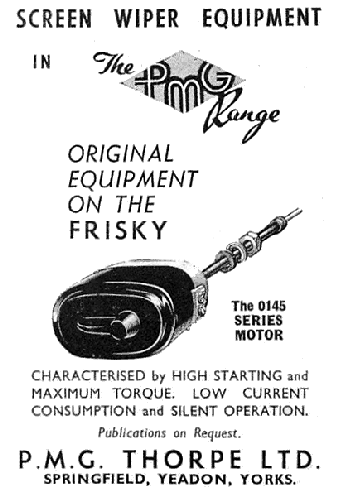 |
|
Two adverts from
1958. |
|
Further information and help with these cars can be obtained from The
Frisky Register (01600 860420) which was been run for over twenty years
by John Meadows the grandson of Henry Meadows who founded Henry Meadows
Ltd.
The address of the Frisky Register is as follows:
Graces Cottage
Tregagle
Monmouth
NP25 4RZ |
|
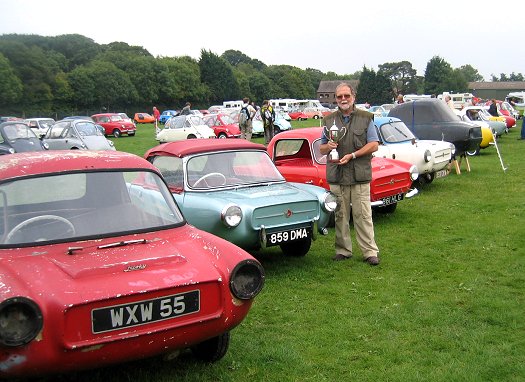
John Meadows and the line-up
of Frisky cars at the 2010 National MicroCar Rally, at the Three Counties Showground, Malvern, Worcestershire. John is holding
the "Spirit of the National" award, presented to him, on
behalf of the Frisky owners, who made the Frisky event
possible.
Courtesy of John Meadows. |
In September 2010, John Meadows organised the
largest line-up of Frisky Cars since about 1980, at the
Three Counties Showground in Malvern, during the
National MicroCar Rally. 13 cars were displayed in
different stages of restoration, which must have been
quite a sight.
The line-up consisted of 3 Frisky Sports, 1 Frisky
Coupé, 6 Family
Threes, 2 mark 2 Family Threes and one Gull Wing
Shell. |
|
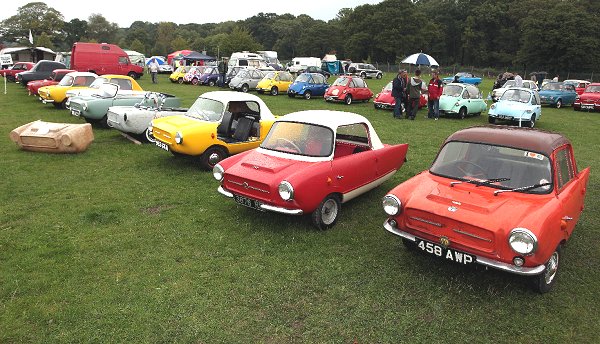
Another view of the line-up at
Malvern. Courtesy of Richard Dredge. |
| John Meadows has kindly informed me that around 75
Frisky cars are known to survive. The majority are mark
1 and mark 2 Family Threes. There are 12 surviving
Frisky Sports, and 4 Frisky Coupés. |
| I would like to thank John Meadows and Keith Peckmore for their help in producing this brief history. |
|
